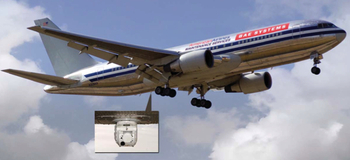 Five
years ago, after a pair of shoulder-fired missiles over
Kenya narrowly missed a packed Israeli passenger jet, the
government in Jerusalem recognized the threat to commercial
aviation -- and sprang into action. By early 2006,
all of the state-owned El Al jetliners were outfitted
with laser countermeasures against these terrorist weapons
of choice.
Five
years ago, after a pair of shoulder-fired missiles over
Kenya narrowly missed a packed Israeli passenger jet, the
government in Jerusalem recognized the threat to commercial
aviation -- and sprang into action. By early 2006,
all of the state-owned El Al jetliners were outfitted
with laser countermeasures against these terrorist weapons
of choice.
The U.S. Department of Homeland Security and America's airline companies, meanwhile, began a round of finger pointing and thumb-sucking.
The countermeasures would cost tens of billions to install and keep up, the feds and the suits complained. Each looked to the other to cover the costs -- as they cited a Rand Corporation study, which warned of $40 billion maintenance bill. (Other estimates said the countermeasures would would cost airlines "$0.003 to operate per available seat mile or about 70 cents per passenger on a 2,000-mile trip" -- "about the cost of a bag of peanuts," plus a weight penalty equivalent to two passengers and bags." ) What's more, the airlines and the government asserted, the American aviation system was too big -- at 6,000 + planes, maybe 20 times larger than the Israeli one. So there was no way they could give American passengers the same level protection that Israeli ones got. After years of Congressional foot-stomping, DHS decided to devote a relatively paltry $90 million or so to try out some cheaper alternatives.
Now, finally, the first three U.S. jetliners -- "American Airlines Boeing 767-200s that fly daily round-trip routes between New York and California -- will receive the anti-missile laser jammers this spring," USA Today reports. BAE's JetEye countermeasure, based on an Army system, uses beam of light to confuse the heat-seeking missiles' guidance system. DHS is spending $29 million on the tests.
But don't expect much to come out of the trials.
American Airlines spokesman John Hotard says company officials agreed to participate in the tests in case Congress eventually requires airlines to install the devices.
But American is "philosophically opposed" to anti-missile technology on commercial planes, he says. "When you look at the cost benefit, it would be an extremely expensive proposition, and in the end, is it really going to work?"
ABC News notes that "at least 24 civilian aircraft worldwide had been brought down by shoulder-to-air missiles brought on the black market for just a few thousand dollars. More than 500 people had been killed."